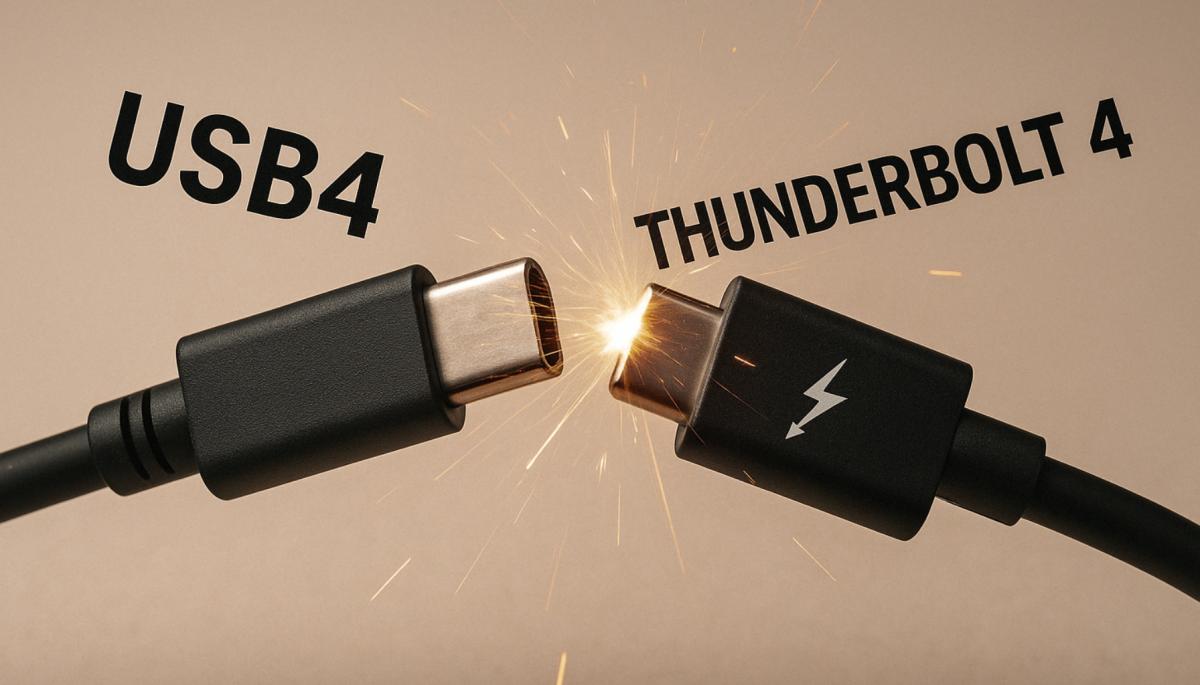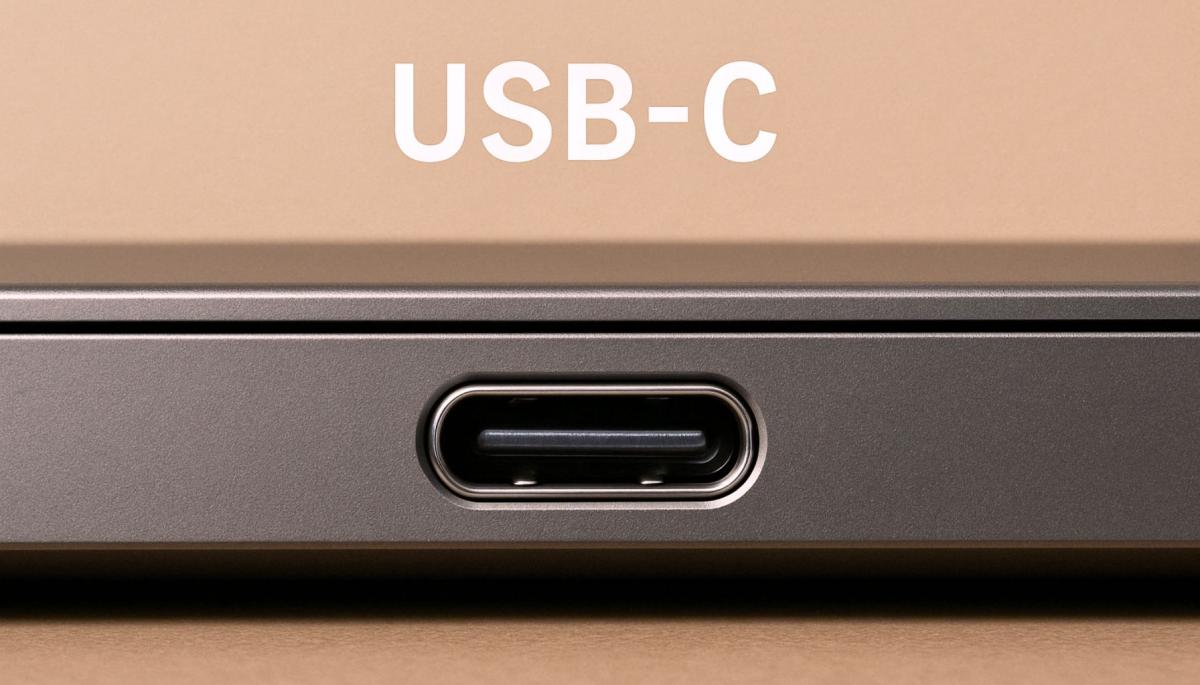Want faster connections and fewer cables? USB4 and Thunderbolt 4 are the future. Our article clearly presents what these technologies can do, how they differ, and which is best for you. Whether you're a gamer or a content creator, USB4 and Thunderbolt 4 make life a lot easier.

If you've ever looked at the specifications of a new laptop, monitor, or docking station, you've probably encountered abbreviations like USB4, Thunderbolt 4, or USB-C. These terms may seem like additional technical jargon that just complicates your life, but they actually represent the future of device connectivity. What is USB4? And is it the same as Thunderbolt 4, or is there a difference between them?
USB4: The True King of Versatility
USB4 is the latest version of the Universal Serial Bus standard which we've been using for years to connect everything from mice to external drives. It was introduced in 2019 by the USB Implementers Forum and represents a significant leap over older versions, such as USB 3.2. It can transfer data at speeds of up to 40 gigabits per second, which is enough to move a massive video file in a flash.
However, some devices with USB4 offer only half the speed, i.e., 20 gigabits per second, so always check the specifications. Besides speed, USB4 supports connecting 4K monitors at 144 Hz, which gamers and content creators will especially appreciate.
Additionally, with support for up to 100W charging via USB-C, you can power a laptop and transfer data with a single cable. What makes USB4 really handy is its ability to handle multiple tasks simultaneously. Through one cable, you can send video and power a device without having to deal with a bunch of different ports.
Moreover, it is backward compatible, so it works with older USB devices, albeit with their limitations. USB4 is simply designed to be as versatile as possible – whether you're connecting a gaming console, an external SSD, or a monitor, this standard handles it all.

Thunderbolt 4: The Premium Class of Connectivity
Thunderbolt 4, introduced by Intel in 2020, is like an enhanced sibling of USB4. It uses the same USB-C connector and builds on a similar foundation, but adds several features that make it more reliable and powerful.
Unlike USB4, where speed can vary, Thunderbolt 4 always guarantees 40 gigabits per second, with at least 32 reserved for data. This means that connecting a super-fast external drive or graphics card is seamless.
Moreover, Thunderbolt 4 mandatorily supports connecting two 4K monitors simultaneously or one 8K monitor, which is great for professionals who need large workspaces. Another feature that sets Thunderbolt 4 apart is its ability to connect multiple devices in a chain – known as daisy-chaining. For example, you can connect a monitor, a disk, and a docking station, all running through one port.
Thunderbolt 4 also adds features like waking devices from sleep mode or fast network connectivity via docking stations. It's simply a standard that's tuned for those who don't want to make compromises.
How Do USB4 and Thunderbolt 4 Differ?
Even though USB4 and Thunderbolt 4 may look similar at first glance, each has its strengths. USB4 is more flexible and usually cheaper because manufacturers don't have to meet stringent requirements. This means it is suitable for a wide range of devices, from phones to gaming consoles, but features can vary depending on the specific model.
Thunderbolt 4, on the other hand, is about certainty – you always know you're getting maximum speed, support for multiple monitors, and other features. However, you will pay more for this consistency because devices with Thunderbolt 4 tend to be more expensive due to licensing and certifications.
Another difference is in compatibility. USB4 works with most older USB standards, but support for Thunderbolt 3 is not guaranteed. Thunderbolt 4, on the other hand, is fully compatible with USB4 and Thunderbolt 3, making it suitable if you already have Thunderbolt devices.
In short, USB4 is great for general use, while Thunderbolt 4 is intended for demanding users.

USB-C is Not USB4 or Thunderbolt 4
Here’s something to clarify, as it can be confusing. USB-C is just a connector – the small oval port you find on most new devices today. It can transfer various standards, from old USB 2.0 to USB4 and Thunderbolt 4. This means that not every USB-C port automatically handles the highest speeds or features.
For example, a cheaper laptop might have a USB-C port that only supports 10 gigabits per second with no video, while a more expensive model might support Thunderbolt 4 with all its features. Always check the technical specifications to know what your port is truly capable of.
Who Needs USB4 and Who Needs Thunderbolt 4?
If you’re an average user looking to quickly transfer files, connect one monitor, or charge a phone, USB4 will probably suffice. It's available on many devices, from laptops to docking stations, and is a great choice for households due to its lower cost. For example, gamers looking to connect a Steam Deck to a high-refresh-rate monitor won't go wrong with USB4.
Thunderbolt 4 is for those who need the maximum. If you’re a graphic designer editing videos on two 4K monitors or a gamer wanting an external graphics card for better performance, Thunderbolt 4 is the way to go. Its ability to chain multiple devices through one cable and ensure top performance is ideal for professional workstations. You'll pay more, but you'll get a device you can rely on.
Where Are USB4 and Thunderbolt 4 Heading?
Both standards are at the forefront now, but technology is always advancing. There’s already talk of USB4 Version 2.0, which could offer speeds up to 80 gigabits per second, surpassing everything Thunderbolt 4 can do.
Intel is likely preparing Thunderbolt 5, which could bring further improvements. Whatever happens, the USB-C connector remains a staple, so you don't have to worry about needing to replace all your cables.
Lost signal? A satellite phone won't leave you disconnected

Losing signal in the middle of the mountains or on the open sea no longer has to mean a loss of connection to the world. A satellite phone works even where regular mobile networks end. In the article, you'll learn how the device connects via satellites, what types of networks exist, how much calls cost, and why satellite communication is becoming more accessible for ordinary users.
Leaked passwords: How to find out if someone has obtained your data

Data breaches happen all the time and can affect anyone. Even strong login credentials can appear in the database of leaked passwords circulating on the internet. In the article, you will learn how to perform a password check using verified tools and find out if someone has gained access to your accounts.
Internet via light or how does Li-Fi work?

With the growing number of connected devices and the increased volume of data being transmitted, new ways are being sought to speed up and improve network efficiency. Internet via light, referred to as Li-Fi technology, uses LED lighting for wireless data transmission and promises higher speed and greater security. Let's see how it works and where it's already being tested.
What will 6G internet bring – lightning-fast connection, smart cities, and artificial intelligence in the network

Mobile networks of the sixth generation will push the boundaries of communication and data transmission. 6G internet will offer speeds in the order of terabits, minimal delay, and integration with artificial intelligence. In the article, we explain how this technology works, how it differs from 5G, what frequencies it uses, and why it is essential for smart cities and modern industry.
Wireless charging: What are its benefits, limitations, and where is it heading?

Wireless charging has evolved from a luxury feature to a standard part of most modern phones. Simply place your mobile on the pad, and energy begins to flow without searching for a cable and connector. We explain how wireless charging works, what it entails, and why Qi and Qi2 technologies have become the new standard of convenience.
What is Wi-Fi 7? What changes does it bring and when does it make sense to switch

Today's home Wi-Fi network is under increasing pressure. It has to handle video calls, online gaming, and dozens of smart devices. The new Wi-Fi 7 standard offers a solution that takes wireless connectivity to the next level. We'll explain what this standard means in practice and why it might be crucial for the future of home and business networks.